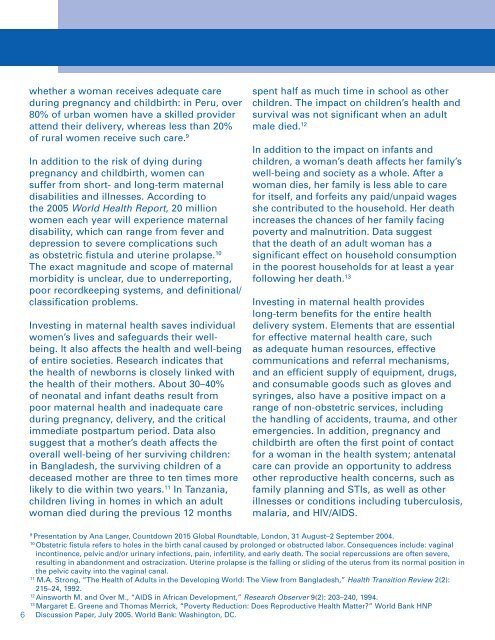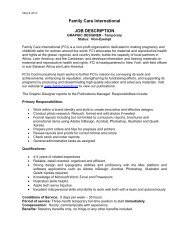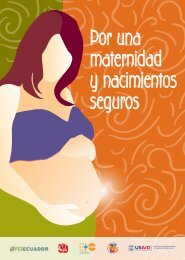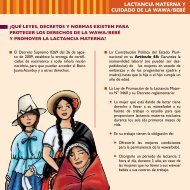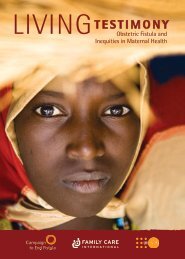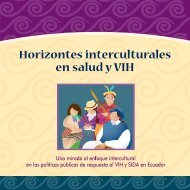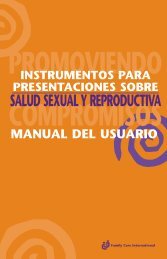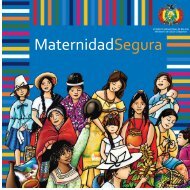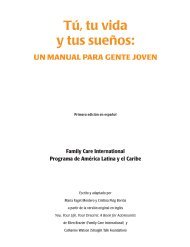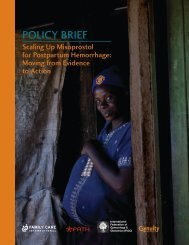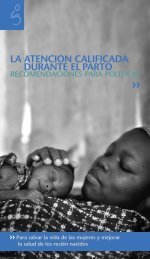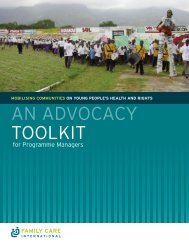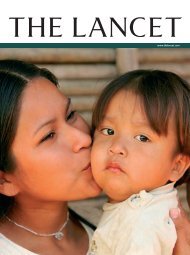Safe Motherhood: A Review - Family Care International
Safe Motherhood: A Review - Family Care International
Safe Motherhood: A Review - Family Care International
You also want an ePaper? Increase the reach of your titles
YUMPU automatically turns print PDFs into web optimized ePapers that Google loves.
whether a woman receives adequate care<br />
during pregnancy and childbirth: in Peru, over<br />
80% of urban women have a skilled provider<br />
attend their delivery, whereas less than 20%<br />
of rural women receive such care. 9<br />
In addition to the risk of dying during<br />
pregnancy and childbirth, women can<br />
suffer from short- and long-term maternal<br />
disabilities and illnesses. According to<br />
the 2005 World Health Report, 20 million<br />
women each year will experience maternal<br />
disability, which can range from fever and<br />
depression to severe complications such<br />
as obstetric fistula and uterine prolapse. 10<br />
The exact magnitude and scope of maternal<br />
morbidity is unclear, due to underreporting,<br />
poor recordkeeping systems, and definitional/<br />
classification problems.<br />
Investing in maternal health saves individual<br />
women’s lives and safeguards their wellbeing.<br />
It also affects the health and well-being<br />
of entire societies. Research indicates that<br />
the health of newborns is closely linked with<br />
the health of their mothers. About 30–40%<br />
of neonatal and infant deaths result from<br />
poor maternal health and inadequate care<br />
during pregnancy, delivery, and the critical<br />
immediate postpartum period. Data also<br />
suggest that a mother’s death affects the<br />
overall well-being of her surviving children:<br />
in Bangladesh, the surviving children of a<br />
deceased mother are three to ten times more<br />
likely to die within two years. 11 In Tanzania,<br />
children living in homes in which an adult<br />
woman died during the previous 12 months<br />
spent half as much time in school as other<br />
children. The impact on children’s health and<br />
survival was not significant when an adult<br />
male died. 12<br />
In addition to the impact on infants and<br />
children, a woman’s death affects her family’s<br />
well-being and society as a whole. After a<br />
woman dies, her family is less able to care<br />
for itself, and forfeits any paid/unpaid wages<br />
she contributed to the household. Her death<br />
increases the chances of her family facing<br />
poverty and malnutrition. Data suggest<br />
that the death of an adult woman has a<br />
significant effect on household consumption<br />
in the poorest households for at least a year<br />
following her death. 13<br />
Investing in maternal health provides<br />
long-term benefits for the entire health<br />
delivery system. Elements that are essential<br />
for effective maternal health care, such<br />
as adequate human resources, effective<br />
communications and referral mechanisms,<br />
and an efficient supply of equipment, drugs,<br />
and consumable goods such as gloves and<br />
syringes, also have a positive impact on a<br />
range of non-obstetric services, including<br />
the handling of accidents, trauma, and other<br />
emergencies. In addition, pregnancy and<br />
childbirth are often the first point of contact<br />
for a woman in the health system; antenatal<br />
care can provide an opportunity to address<br />
other reproductive health concerns, such as<br />
family planning and STIs, as well as other<br />
illnesses or conditions including tuberculosis,<br />
malaria, and HIV/AIDS.<br />
9 Presentation by Ana Langer, Countdown 2015 Global Roundtable, London, 31 August–2 September 2004.<br />
10 Obstetric fistula refers to holes in the birth canal caused by prolonged or obstructed labor. Consequences include: vaginal<br />
incontinence, pelvic and/or urinary infections, pain, infertility, and early death. The social repercussions are often severe,<br />
resulting in abandonment and ostracization. Uterine prolapse is the falling or sliding of the uterus from its normal position in<br />
the pelvic cavity into the vaginal canal.<br />
11 M.A. Strong, “The Health of Adults in the Developing World: The View from Bangladesh,” Health Transition <strong>Review</strong> 2(2):<br />
215–24, 1992.<br />
12 Ainsworth M. and Over M., “AIDS in African Development,” Research Observer 9(2): 203–240, 1994.<br />
13 Margaret E. Greene and Thomas Merrick, “Poverty Reduction: Does Reproductive Health Matter?” World Bank HNP<br />
Discussion Paper, July 2005. World Bank: Washington, DC.


